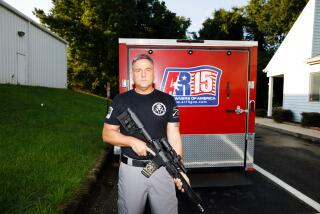Sea of Change in Big-Game Hunting
- Share via
Steve Alexander has lots of big fish hanging on his walls.
There’s the 300-pound black sea bass he got in Baja California. A 92-pound gulf grouper reminds him of another trip south. And a 54-pound yellowtail comes close to breaking the record for that species.
All the fish were shot by Alexander--with the sleek custom teak spear guns he handcrafts for a living.
“I just like building things,” explains the 49-year-old Costa Mesa resident. “I figured I may as well build something that I’m also involved in.”
One of a handful of cottage custom spear gun producers in America, the former mold maker creates big-game guns--called Alexanders--that are well-known by divers on the West Coast and in Hawaii.
“It’s probably one of the finest spear guns available,” says Harry Ingram, a longtime diver who has been using an Alexander for years. “They are just beautiful guns; Steve is an artist.”
Alexander got his start in making spear guns after discovering spearfishing seven years ago. An avid line fisherman at the time, he was fishing aboard his boat off Catalina one day when he ran into some spearfishermen shooting yellowtail.
“I had never heard of that,” he recalls. “I started talking to them and attended a couple meetings of their club. The difference between fishing and spearfishing is that you don’t have to sit on your boat and wait for something to happen.”
Within a few weeks, he was trying his hand at the sport. Like most avid spearfishermen, Alexander shuns the unsportsmanlike scuba gear. Instead he dons only a mask, fins, snorkel and wet suit, holding his breath long enough to descend to where the fish roam.
But he soon became frustrated with the quality of the commercial spear guns available. Primarily designed to shoot small fish at close range, they just did not pack the wallop or accuracy necessary to bag the big game that was becoming popular among the sport’s most ardent practitioners. So Alexander began tinkering.
“I started modifying and trying to make it better,” he recalls. “What I found was that it just wasn’t up to what we were doing, so I started from scratch and built a whole new gun.”
From fine-grained teakwood, Alexander fashioned a longer stock--making it more powerful--than most being made. Then he manufactured a handle, trigger mechanism, spear shaft and tip designed for high performance against big fish at great distances.
The first guns were for personal use only. Later he began making them on request for friends. Finally, when the bottom fell out of his mold-making business four years ago, Alexander began producing and selling his special brand of spear gun full time.
Today, he says, he sells about 30 guns a year ranging in price from $294 for a 46-inch one capable of shooting a small fish from 12 feet away, to $648 for a six-footer that can bag big game at 35 feet. Alexander’s guns cost 30% to 40% more than guns of the same size that are commercially produced and sold in diving shops.
The waiting period for the spear guns--for which he also sells parts--is two to four months, Alexander says. “I’ve never advertised,” he says of his business, which supplies spear guns for divers up and down the West Coast, in Hawaii and as far away as Florida. “It’s all been word of mouth.”
Word of mouth has it that the guns are worth waiting for.
Terry Maas, a Ventura diver considered one of the best spearfishermen in the world, says he recommends them to friends who ask what gun they should use. “He’s got the closest gun to the state of the art that there is right now,” Maas says. “He’s a fine craftsman and has sound mechanisms.”
And Ingram swears by his Alexander as if it were a longtime companion. “The guy’s just a perfectionist,” he says of the spear gun maker. Shooting one of his spear guns, Ingram says, “is like squeezing the hand of a pretty girl.”
When Alexander is not making spear guns, he can usually be found shooting them. A member of the Long Beach Neptunes, a spearfishing club, he has traveled worldwide to bag big game, but there’s an irony to his fervor.
The fact is, the spearfisherman admits, “I don’t eat fish. I just don’t like ‘em. The reason I hang them on the wall is to justify shooting them.”
More to Read
Sign up for The Wild
We’ll help you find the best places to hike, bike and run, as well as the perfect silent spots for meditation and yoga.
You may occasionally receive promotional content from the Los Angeles Times.






